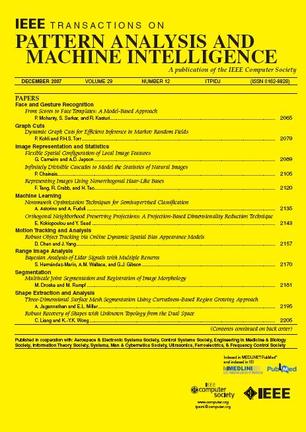SPTS v2:单点场景文本识别
IF 20.8
1区 计算机科学
Q1 COMPUTER SCIENCE, ARTIFICIAL INTELLIGENCE
IEEE Transactions on Pattern Analysis and Machine Intelligence
Pub Date : 2023-01-04
DOI:10.48550/arXiv.2301.01635
引用次数: 1
摘要
端到端场景文本识别由于文本检测和识别之间的内在协同作用而取得了重大进展。以往的方法通常以手工标注为前提,如水平矩形、旋转矩形、四边形、多边形等,这比单点标注要昂贵得多。我们的新框架SPTS v2允许我们使用单点注释训练高性能的文本识别模型。SPTS v2保留了具有实例分配解码器(IAD)的自回归转换器的优点,通过顺序地预测同一预测序列内所有文本实例的中心点,而具有并行识别解码器(PRD)的文本并行识别,这大大降低了对序列长度的要求。这两个解码器具有相同的参数,通过简单而有效的信息传输过程交互连接,传递梯度和信息。在各种现有基准数据集上的综合实验表明,SPTS v2可以用更少的参数胜过以前最先进的单点文本观测者,同时实现19倍的推理速度。在我们的SPTS v2框架的背景下,我们的实验表明,与其他表示相比,单点表示在场景文本识别中具有潜在的偏好。这种尝试为超越现有范例领域的场景文本识别应用提供了重要的机会。代码可从https://github.com/Yuliang-Liu/SPTSv2获得。本文章由计算机程序翻译,如有差异,请以英文原文为准。
SPTS v2: Single-Point Scene Text Spotting
End-to-end scene text spotting has made significant progress due to its intrinsic synergy between text detection and recognition. Previous methods commonly regard manual annotations such as horizontal rectangles, rotated rectangles, quadrangles, and polygons as a prerequisite, which are much more expensive than using single-point. Our new framework, SPTS v2, allows us to train high-performing text-spotting models using a single-point annotation. SPTS v2 reserves the advantage of the auto-regressive Transformer with an Instance Assignment Decoder (IAD) through sequentially predicting the center points of all text instances inside the same predicting sequence, while with a Parallel Recognition Decoder (PRD) for text recognition in parallel, which significantly reduces the requirement of the length of the sequence. These two decoders share the same parameters and are interactively connected with a simple but effective information transmission process to pass the gradient and information. Comprehensive experiments on various existing benchmark datasets demonstrate the SPTS v2 can outperform previous state-of-the-art single-point text spotters with fewer parameters while achieving 19× faster inference speed. Within the context of our SPTS v2 framework, our experiments suggest a potential preference for single-point representation in scene text spotting when compared to other representations. Such an attempt provides a significant opportunity for scene text spotting applications beyond the realms of existing paradigms. Code is available at: https://github.com/Yuliang-Liu/SPTSv2.
求助全文
通过发布文献求助,成功后即可免费获取论文全文。
去求助
来源期刊
CiteScore
28.40
自引率
3.00%
发文量
885
审稿时长
8.5 months
期刊介绍:
The IEEE Transactions on Pattern Analysis and Machine Intelligence publishes articles on all traditional areas of computer vision and image understanding, all traditional areas of pattern analysis and recognition, and selected areas of machine intelligence, with a particular emphasis on machine learning for pattern analysis. Areas such as techniques for visual search, document and handwriting analysis, medical image analysis, video and image sequence analysis, content-based retrieval of image and video, face and gesture recognition and relevant specialized hardware and/or software architectures are also covered.

 求助内容:
求助内容: 应助结果提醒方式:
应助结果提醒方式:


